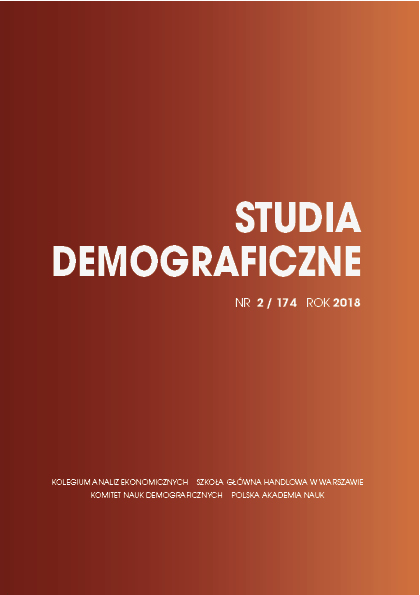Cohort fertility of Polish women, 1945–2015: the context of postponement and recuperation
Main Article Content
Abstract
The article is a follow-up and an extension to previously published papers by Holzer-Żelażewska & Holzer (1997) and Holzer-Żelażewska & Tymicki (2009). Fristly, we have added new cohorts to the cohort analysis based on the individual data from births registration for the years 2009–2015. Secondly, we have extended the scope of the study by taking into account the context of postponement and recuperation to analyses of cohort fertility of Polish women.
The approach applied to the fertility postponement and recuperation on the cohort data refers to the method which was originally proposed by Frejka (2011) and Lesthaeghe (2001) and further developed by Sobotka et al. (Sobotka et al., 2011). This method allows for calculation of fertility postponement and recuperation measures with respect to a benchmark cohort chosen as the one that first experiences an onset of the increase in the mean age of motherhood at first birth.
The results show the remarkable changes in the fertility patterns in Poland. The main driving forces behind the change in fertility patterns in Poland are related to the postponement of first births along with a relatively good recuperation. The magnitude of recuperation for Polish cohorts dropped significantly for second births and was almost non-existent for third and higher births. Therefore, the pattern of fertility in Poland observed till 2015 could be characterized by postponement and recuperation of first births along with a significant decrease in second births with perpetual postponement of third and higher births.
Article Details
References
[2] Bolesławski, L., 1993, Polskie tablice dzietności kobiet 1971–1992 [Polish fertility tables 1971–1992], Warszawa: Główny Urząd Statystyczny.
[3] DESTATIS, 2016, Live births: Germany, years, citizenship. GENESIS-Online Datenbank, retrieved on 3.4.2017 from: https://www-genesis.destatis.de/genesis/online
[4] Dormon, O., 2014, Childbearing of UK and non-UK born women living in the UK: 2011 Census data. Office for National Statistics, retrieved on 3.4.2017 from: http://webarchive.nationalarchives. gov.uk/20160105160709/http://ons.gov.uk/ons/rel/fertility-analysis/childbearing-of-uk-and-non-uk-born-women-living-in-the-uk/2011‑census-data/index.html
[5] Fihel, A., Jasilionis, D., 2016, About mortality data for Poland. Human Mortality Database country documentation file, retrieved from: http://www.mortality.org/
[6] Frątczak, E., Ptak-Chmielewska, A., Pęczkowski, M., 2011a, Płodność w Polsce – analiza kohortowa: kohorty urodzeniowe 1911–1986, Tom I, Warszawa: OW SGH.
[7] Frątczak, E., Ptak-Chmielewska, A., Pęczkowski, M., 2011b, Płodność w Polsce – analiza kohortowa: kohorty urodzeniowe 1911–1986, Tom II, Warszawa: OW SGH.
[8] Frejka, T., Calot, G., 2001, Cohort Reproductive Patterns in Low-Fertility Countries, ”Population and Development Review” 27 (1), 103–132.
[9] Frejka, T., Sardon, J. P., 2004, Childbearing trends and prospects in low-fertility countries, [in:] European Studies of Population 13, Dordrecht: Kluwer Academic Publishers.
[10] Frejka, T., 2011, The Role of Contemporary Childbearing Postponement and Recuperation in Shaping Period Fertility Trends, “Comparative Population Studies” 36 (4), 927–958.
[11] Frejka, T., Gietel-Basten, S., 2016, Fertility and Family Policies in Central and Eastern Europe after 1990, “Comparative Population Studies” 41 (1), 3–56.
[12] Gołata, E., 2016, Estimation of fertility in Poland and of Polish born women in the United Kingdom, “Studia Demograficzne” 1 (169), 13–38.
[13] GUS, 2015, Informacja o rozmiarach i kierunkach czasowej emigracji z Polski w latach 2004– 2014. Notatka informacyjna 5.10.2015 r., Warszawa: Główny Urząd Statystyczny.
[14] GUS, 2016a, Prognoza ludności rezydującej dla Polski na lata 2015–2050, Główny Urząd Statystyczny, Warszawa.
[15] GUS 2016b, Informacja o rozmiarach i kierunkach czasowej emigracji z Polski w latach 2004– 2015. Notatka informacyjna 5.10.2015 r., Warszawa: Główny Urząd Statystyczny.
[16] GUS, 2017, Ludność i ruch naturalny w 2016, Warszawa: Główny Urząd Statystyczny.
[17] GUS, 2018, Sytuacja demograficzna Polski do 2017 r. Urodzenia i dzietność [Demographic situation in Poland up to 2017. Births and fertility], Warszawa: Główny Urząd Statystyczny.
[18] HFD – Human Fertility Database, 2018, Max Planck Institute for Demographic Research (Germany) and Vienna Institute of Demography (Austria), retrieved from: www.humanfertility.org
[19] Holzer, J. Z., Holzer-Żelażewska, D., 1997, Płodność kohortowa kobiet w Polsce w latach 1945– 1994, “Studia Demograficzne” no. 2, 3–23.
[20] Holzer-Żelażewska, D., Tymicki, K., 2009, Cohort and period fertility of Polish women, 1945– 2008, “Studia Demograficzne” no. 1, 48–69.
[21] Jasilioniene, A., Jdanov, D. A., Sobotka, T., Andreev, E. M., Zeman, K., Shkolnikov, V. M., Goldstein, J. R., Philipov, D., Rodrígues, G., 2009, Methods protocol for the Human Fertility Database, retrieved from: www.humanfertility.org/Docs/methods.pdf
[22] Kaczmarczyk, P., 2014, Recent Trends in International Migration in Poland. The 2012 SOPEMI Report, CMR Working Papers 71/129, Centre of Migration Research, University of Warsaw.
[23] Kohler, H.‑P. et al., 2002, The Emergence of Lowest-Low Fertility in Europe During the 1990s, “Population and Development Review” 28 (4), 641–680.
[24] Kotowska, I. E., 2018, Czy Program Rodzina 500 Plus umożliwi trwałe odwrócenie spadku urodzeń w Polsce?, unpublished manuscript.
[25] Lesthaeghe, R., 2001, Postponement and recuperation: Recent fertility trends and forecasts in six Western European countries, the paper presented at the IUSSP Seminar “International perspectives on low fertility: Trends, theories and policies”, Tokyo, 21–23 March 2001.
[26] Paradysz, J., 1992, Dzietność kobiet w Polsce, Warszawa: Główny Urząd Statystyczny.
[27] Myrskylä, M., Goldstein, J. R., Cheng, Y. A., 2013, New Cohort Fertility Forecasts for the Developed World, “Population and Development Review” 39 (1), 31–56.
[28] ONS, 2016, Parents' country of birth 2015, Office for National Statistics, retrieved on 3.4.2017 from: https://www.ons.gov.uk/peoplepopulationandcommunity/birthsdeathsandmarriages/livebirths/datasets/parentscountryofbirth
[29] Sobotka, T., Zeman, K., Leshaeghe, R., Frejka, T., Neels, K., 2011, Postponement and Recuperation in Cohort Fertility: Austria, Germany, Switzerland in a European Context, “Comparative Population Studies” 36 (2–3), 417–452.
[30] Tymicki, K., Zeman, K., 2017, Human Fertility Database documentation: Poland, retrieved from: http://www.humanfertility.org
[31] Waller L., Berrington A. and Raymer J., 2014, New insights into the fertility patterns of recent Polish migrants in the United Kingdom, “Journal of Population Research” 2 (31), 131–150.
[32] Zeman, K., Beaujouan, E., Brzozowska, Z., Sobotka, T., 2017, Cohort fertility decline in low fertility countries: Decomposition using parity progression ratios, “Demographic Research” 36 (25), 651–690.
